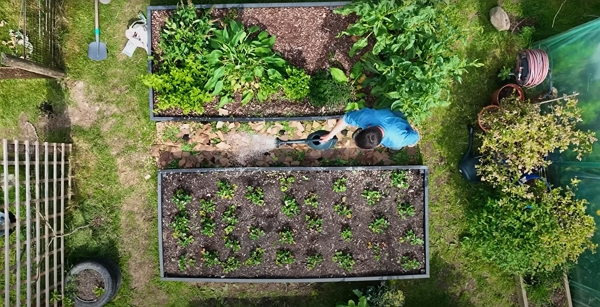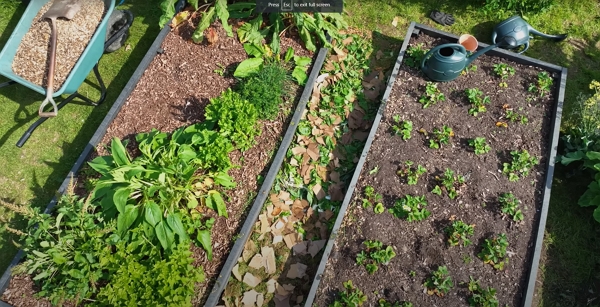Sometimes it’s difficult to build a compost bin. Huw shares a trick to do without.
Thanks to Huw Richards for sharing his wisdom and knowledge! I wrote the following notes watching the video published on Huw Richards’s channel. You can watch it using this YouTube link.
The source of the idea
Liz Zorab inspired Huw with this concept.
She uses a lot of woodchips in her garden alleys. After a while, she observed that the woodchips had turned into a dark broken-down material thanks to the traffic in the garden, the rain, the wind and the duck roaming.
She then told herself that she could use this woodchip compost in her garden.
then, you simply fork it from the pathways to the beds right beside it!
Woodchip hybrid compost
Huw suggests a hybrid solution, using kitchen scraps and other garden waste to create a nitrogen-rich compost.
Here are the steps:
Protect wooden beds
If you go for this technique, you will need to protect the wooden beds with an empty compost bag, for example.
Apply a cardboard base
Especially if you have grass paths, it’s ideal to apply a layer of cardboard.
It still allows earth contact between the soil life.
Calculate the volume of compost it can create
In Huw’s example, his pathway measures 3 meters long and 55 cm wide. He planned to put a 15 cm layer of material.
He would get about 250 liters of compost in the end!
How beneficial is it
If you have beds like Huw that measure 3 m by 1.2 m and you apply 3 cm of compost, 108 liters of compost. So with one alley, you can deal with the two beds surrounding it!
Applying the materials
- apply a 3 cm layer of woodchips, as the base layer.
- throw on top of it any weeds that you find in the nearby beds.
- add more shredded cardboard.
- add your vegetable waste or comfrey leaves.
- add kitchen scraps (but add something else on top like leaves or more cardboard) .6. finish with a good soaking if you lack rain.
You can also add a few sprinkles of leaf mold.
Speed up the process and maintenance
Walking in the pathways is the first step. Your weight helps to break down.
Do add regularly water, more material as it slowly breaks down.
It will bring enough air to the organisms breaking down the materials.
What’s next
Try it yourself with a portion of your garden pathways. And share your observations!


